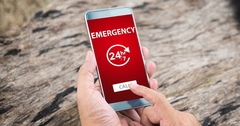
In an era defined by rapid technological advancements, the landscape of disaster preparedness has undergone a significant transformation. Technology plays a pivotal role in enhancing our ability to predict, respond to, and recover from disasters of varying scales. From early warning systems to innovative communication tools, this blog post delves into the multifaceted role of technology in modern disaster preparedness, exploring how these advancements are shaping our approach to mitigating and managing the impact of natural and man-made disasters.
Early Warning Systems
One of the fundamental aspects of effective disaster preparedness is the ability to provide timely warnings to communities at risk. Technology has revolutionized early warning systems, offering real-time data collection and analysis capabilities. Meteorological instruments, satellites, and ground sensors work in tandem to monitor environmental conditions and detect anomalies that could indicate an impending disaster. For instance, sophisticated weather forecasting models can predict hurricanes, tornadoes, and floods with greater accuracy, allowing authorities to issue timely warnings and evacuate vulnerable areas.
Communication Technologies
Communication is a linchpin in disaster management, and technology has exponentially improved our ability to disseminate information swiftly and efficiently. Mobile phones, social media platforms, and dedicated disaster management apps empower individuals to receive alerts, access evacuation routes, and stay informed during critical times. Moreover, the integration of Artificial Intelligence (AI) in communication systems enables automated and personalized alerts, ensuring that relevant information reaches the right people in a timely manner.
Drones and Aerial Surveillance
Unmanned Aerial Vehicles (UAVs), commonly known as drones, have emerged as indispensable tools in disaster preparedness and response. Equipped with high-resolution cameras and sensors, drones can swiftly survey disaster-stricken areas, providing real-time imagery to aid in damage assessment, search and rescue operations, and resource allocation. The use of drones enhances situational awareness and helps responders make informed decisions, particularly in areas that are difficult to access or too dangerous for human intervention.
Predictive Analytics and Big Data
The marriage of predictive analytics and big data has ushered in a new era of disaster preparedness. Predictive analytics can forecast potential risks and vulnerabilities by analyzing vast datasets, including historical disaster patterns, demographic information, and environmental factors. This data-driven approach enables authorities to allocate resources strategically, plan for evacuations, and implement preventive measures, ultimately minimizing the impact of disasters on communities.
Smart Infrastructure and IoT
The rise of the Internet of Things (IoT) has paved the way for smart infrastructure that can withstand and respond to disasters more effectively. Sensors embedded in buildings, bridges, and critical infrastructure components can detect structural abnormalities or stress, providing early warnings of potential failures. Additionally, smart grids and energy management systems enhance the resilience of power networks, ensuring a more reliable energy supply during and after disasters.
Blockchain for Disaster Relief
Blockchain technology is gaining traction in disaster relief efforts because it enhances transparency, traceability, and efficiency in aid distribution. During emergencies, blockchain can be used to create decentralized, tamper-proof ledgers, enabling more accountable and secure transactions. This ensures that resources, donations, and aid reach the intended recipients, fostering trust in the humanitarian aid process.
Virtual Reality (VR) for Training and Simulation
Effective disaster response requires well-trained and prepared personnel. Virtual Reality (VR) technology offers immersive training simulations for emergency responders, allowing them to practice various scenarios in a controlled environment. From firefighting to medical triage, VR simulations enhance the skills of responders and prepare them for the challenges they may face in real-world disaster situations.
Community Engagement through Social Media
Social media platforms have become instrumental in disaster preparedness and response by facilitating real-time communication and community engagement. Local authorities and emergency services can use social media to disseminate critical information, receive updates from residents, and coordinate volunteer efforts. This direct and immediate communication channel fosters a sense of community resilience and empowers individuals to participate actively in disaster preparedness.
The integration of technology into modern disaster preparedness is a testament to our ability to innovate and adapt in the face of evolving challenges. From early warning systems that leverage advanced meteorological data to the use of drones for rapid response, technology enhances our capacity to mitigate the impact of disasters and protect vulnerable communities. As we continue to explore new frontiers in Artificial Intelligence, blockchain, and other cutting-edge technologies, the future of disaster preparedness holds the promise of even more sophisticated, efficient, and collaborative approaches to safeguarding lives and minimizing the consequences of unforeseen events. Embracing and investing in these technological advancements is not just a matter of progress; it is a commitment to building resilient communities capable of withstanding the unpredictable forces of nature and man-made disasters alike.
